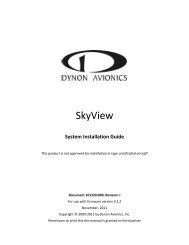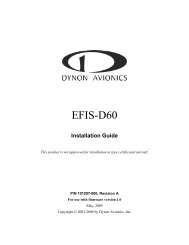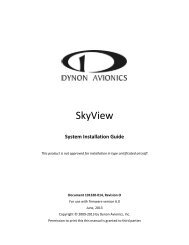EFIS-D100 Installation Guide - Dynon Avionics
EFIS-D100 Installation Guide - Dynon Avionics
EFIS-D100 Installation Guide - Dynon Avionics
You also want an ePaper? Increase the reach of your titles
YUMPU automatically turns print PDFs into web optimized ePapers that Google loves.
Autopilot <strong>Installation</strong> and Configuration<br />
AP CONTROLS ELECTRICAL INSTALLATION<br />
Circuit Breaker/Switch Install a circuit breaker or switch in a location that is accessible to the<br />
pilot while in flight.<br />
AP Disengage/Control Wheel Steering Button<br />
The AP Disengage/CWS button should be in a very accessible location, usually mounted to the<br />
stick or yoke. This button’s primary purpose is to immediately disengage the autopilot. When<br />
configured in the <strong>EFIS</strong> > SETUP > AP > BUTTON CONFIG menu, this button can also be used<br />
to engage the Autopilot from an “off” status by holding the button for more than 2 seconds.<br />
This button should be a Single Pole, Normally Open, Momentary button. Verify that two<br />
terminals of the button are shorted when the button is pressed and open (no-connect) when the<br />
button is released. One terminal of the button should connect to both servos’ yellow wires, and<br />
the other should connect to ground.<br />
While not required, you may install a 5 kΩ resistor across the AP Disengage/CWS button. When<br />
configured in the <strong>EFIS</strong> > SETUP > AP > BUTTON CONFIG > RESISTOR INST menu, the<br />
<strong>EFIS</strong> monitors the disengage line and displays a warning when a broken connection is detected.<br />
AP74 ELECTRICAL INSTALLATION<br />
When installing the AP74, we recommend building enough slack wiring into the D25<br />
connector to allow the AP74 to be removed from its tray with the connector attached.<br />
Use the D-sub pins/connector kit included with your AP74 to make the following connections:<br />
Pin 3: <strong>Dynon</strong> Smart <strong>Avionics</strong> Bus (DSAB) “A”, connected in parallel with all other DSAB B<br />
connections (Blue wire on <strong>Dynon</strong>-supplied wiring harnesses)<br />
Pin 4: Power, 10 - 30 volts DC<br />
Pin 16: <strong>Dynon</strong> Smart <strong>Avionics</strong> Bus (DSAB) “B”, connected in parallel with all other DSAB<br />
A connections (Green wire on <strong>Dynon</strong>-supplied wiring harnesses)<br />
Pin 17: Aircraft Ground<br />
Pin 25: Outer terminal of AP Audio Adjustment Potentiometer (detailed below); If HS34<br />
installed and providing audio to your intercom system, do not connect the AP74 audio out. If<br />
both the HS34 and AP74 Voice/Tone outputs are connected to your intercom, audio alerts<br />
will be distorted.<br />
Ensure that the AP74 audio output is connected similar to the following diagram. The 10 kΩ<br />
variable resistor can be obtained from Radio Shack (P/N 271-1715) or other electronics<br />
suppliers. The potentiometer does not need to be pilot-accessible as it is typically adjusted only<br />
during setup and configuration. See Step 6 - Audio Alerts Configuration on page 6-23.<br />
Outside terminal<br />
Center terminal<br />
Outside terminal<br />
To AP74 pin 5 - Audio<br />
Alert Out<br />
To intercom/audio<br />
panel auxiliary input.<br />
Aircraft ground<br />
<strong>EFIS</strong>-<strong>D100</strong> <strong>Installation</strong> <strong>Guide</strong> 6-5
















